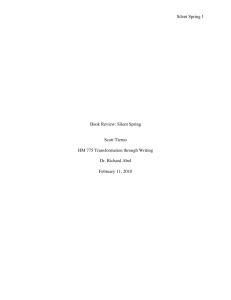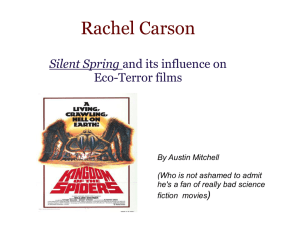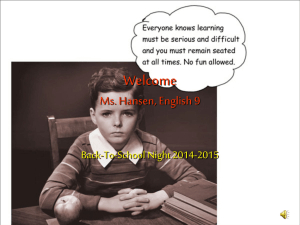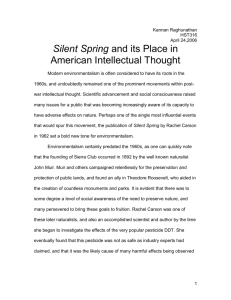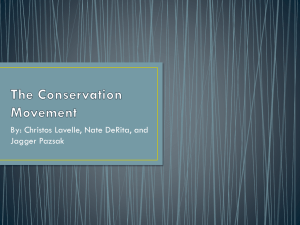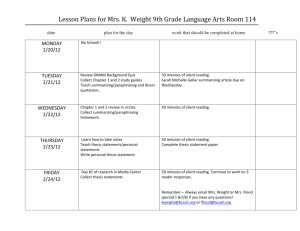II. Silent Spring
advertisement
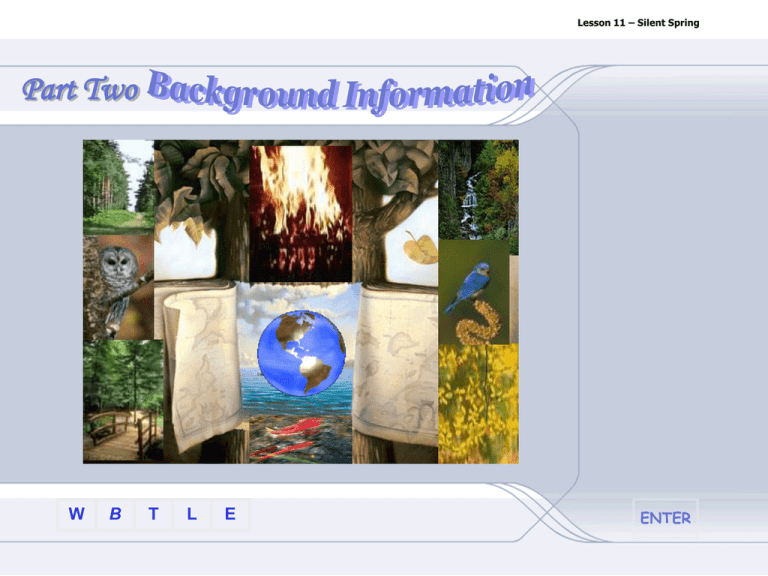
Lesson 11 – Silent Spring Part Two W B T L E ENTER Lesson 11 – Silent Spring Background Information I. Author II. Silent Spring III.Pesticide W B T L E Lesson 11 – Silent Spring I. Author Rachel Carson (1907— 1964) was an American biologist and writer. She was a quiet, private person, fascinated with the workings of nature from a scientific and aesthetic point of view. W B T L E To be continued on the next page. Lesson 11 – Silent Spring I. W Author grew up on a small Pennsylvania farm, went to the Pennsylvania College, majored in zoology, and then went to John Hopkins for a master’s degree in genetics. published Under the Sea-Wind, then The Sea Around Us and The Edge of the Sea, and finally Silent Spring in 1962. In the wake of Silent Spring, she was attacked personally and as a scientist by many. While she was working on Silent Spring, she was seriously ill, a niece died and left a young son whom she adopted, her mother died, and she learned she had breast cancer. died two years after Silent Spring was published, at age 56. B T L E To be continued on the next page. Lesson 11 – Silent Spring I. Author Quotes from Rachel Carson It is the public that is being asked to assume the risks that the insect controllers calculate. The public must decide whether it wishes to continue on the present road, and it can do so only when in full possession of the facts. We still talk in terms of conquest. We still haven't become mature enough to think of ourselves as only a tiny part of a vast and incredible universe. Man's attitude toward nature is today critically important simply because we have now acquired a fateful power to alter and destroy nature. W B T L E To be continued on the next page. Lesson 11 – Silent Spring I. Author Quotes from Rachel Carson But man is a part of nature, and his war against nature is inevitably a war against himself. The rains have become an instrument to bring down from the atmosphere the deadly products of atomic explosions. Water, which is probably our most important natural resource, is now used and re-used with incredible recklessness. Now, I truly believe, that we in this generation, must come to terms with nature, and I think we’re challenged as mankind has never been challenged before to prove our maturity and our mastery, not of nature, but of ourselves. W B T L E To be continued on the next page. Lesson 11 – Silent Spring I. Author Quotes from Rachel Carson The more clearly we can focus our attention on the wonders and realities of the universe about us, the less taste we shall have for destruction. Those who dwell, as scientists or laymen, among the beauties of the earth are never alone or weary in life… Those who contemplate the beauty of the earth find reserves of strength that will endure as long as life lasts. W B T L E The end of Author. Lesson 11 – Silent Spring II. Silent Spring received a letter from a friend in the summer of 1957, saying that an airplane hired by the state spraying DDT to control mosquitoes. shocked by how extensive the pesticide situation was; decided to write about it and let people know. W B T L E To be continued on the next page. Lesson 11 – Silent Spring II. Silent Spring Summary of the book The book starts with a fable of a lovely rural town that suddenly suffers blight, sickness, and death. Its people finally realize they had poisoned themselves. She presented scientific evidence that this was happening all over the country. She explained in plain terms how the strongest bugs survive, making stronger pesticides necessary, and that DDT, though scarce in the water, becomes concentrated as it works its way up the food chain. She advocated integrated management: using a minimum of chemicals combined with biological and cultural controls. W B T L E To be continued on the next page. Lesson 11 – Silent Spring II. Silent Spring Significance of the book It roused a new public awareness that nature was vulnerable to human intervention. She proposed that, at times, technological progress is so fundamentally at odds with natural processes that it must be curtailed. Conservation had never raised much broad public interest, for few people really worried about the disappearance of wilderness. But the threats she had outlined—the contamination of the food chain, cancer, genetic damage, the deaths of entire species—were too frightening to ignore. For the first time, the need to regulate industry in order to protect the environment became widely accepted, and environmentalism was born. W B T L E To be continued on the next page. Lesson 11 – Silent Spring II. Silent Spring Significance of the book Thomas Paine's Common Sense galvanized radical sentiment in the early days of the American Revolution. Harriet Beecher Stowe’s Uncle Tom's Cabin roused Northern antipathy to slavery in the decade leading up to the Civil War. Rachel Carson's Silent Spring, which exposed the hazards of the pesticide DDT, eloquently questioned humanity's faith in technological progress and helped set the stage for the environmental movement. W B T L E To be continued on the next page. Lesson 11 – Silent Spring II. Silent Spring The book that her efforts resulted in was about the spraying and what it did to the birds and other creatures. But that does not begin to describe its scope or account for its impact. One might just as well say that Darwin wrote about turtles and the Pacific islands where they were found. (Esquire magazine) With the publication of Silent Spring in 1962, Rachel Louise Carson, the essence of gentle scholarship, set off a nationally publicized struggle between the proponents and opponents of the widespread use of poisonous chemicals to kill insects. Miss Carson was an opponent. (The New York TIMES) W B T L E The end of Silent Spring. Lesson 11 – Silent Spring III. Pesticide DDT (invented in 1874) came into common use around 1939, especially for insect control for the army during World War II. Its inventor was awarded the Nobel Prize. DDT, the most powerful pesticide the world had ever known, exposed nature’s vulnerability. Unlike most pesticides, whose effectiveness is limited to destroying one or two types of insects, DDT was capable of killing hundreds of different kinds at once. W B T L E To be continued on the next page. Lesson 11 – Silent Spring III. Pesticide • Developed in 1939, it first distinguished itself during World War II, clearing South Pacific islands of malaria-causing insects for U.S. troops, while in Europe being used as an effective delousing powder. • When DDT became available for civilian use in 1945, there were only a few people who expressed second thoughts about this new miracle compound. W B T L E To be continued on the next page. Lesson 11 – Silent Spring III. Pesticide • President John F. Kennedy ordered the President’s Science Advisory Committee to examine the issues the book raised. As a result, DDT came under much closer government supervision and was eventually banned. The public debate moved quickly from whether pesticides were dangerous to which pesticides were dangerous, and the burden of proof shifted from the opponents of unrestrained pesticide use to the chemicals’ manufacturers. W B T L E The end of Pesticide. Lesson 11 – Silent Spring Part Two This is the end of Part Two. Please click HOME to visit other parts. W B T L E

